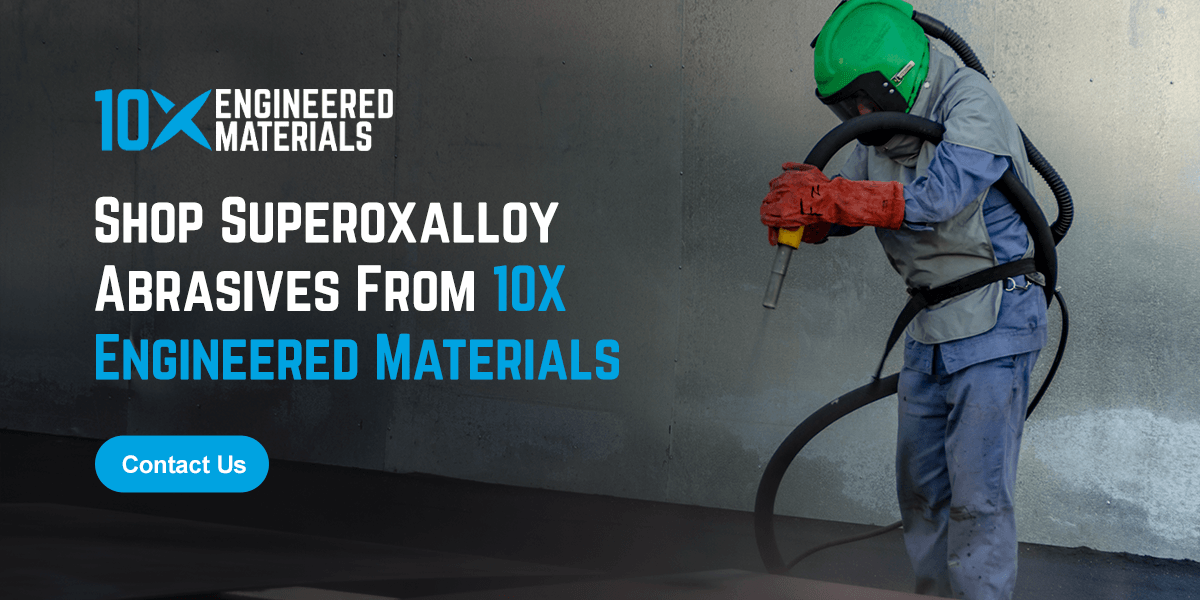Superoxalloy Abrasive vs. Chemical Strippers
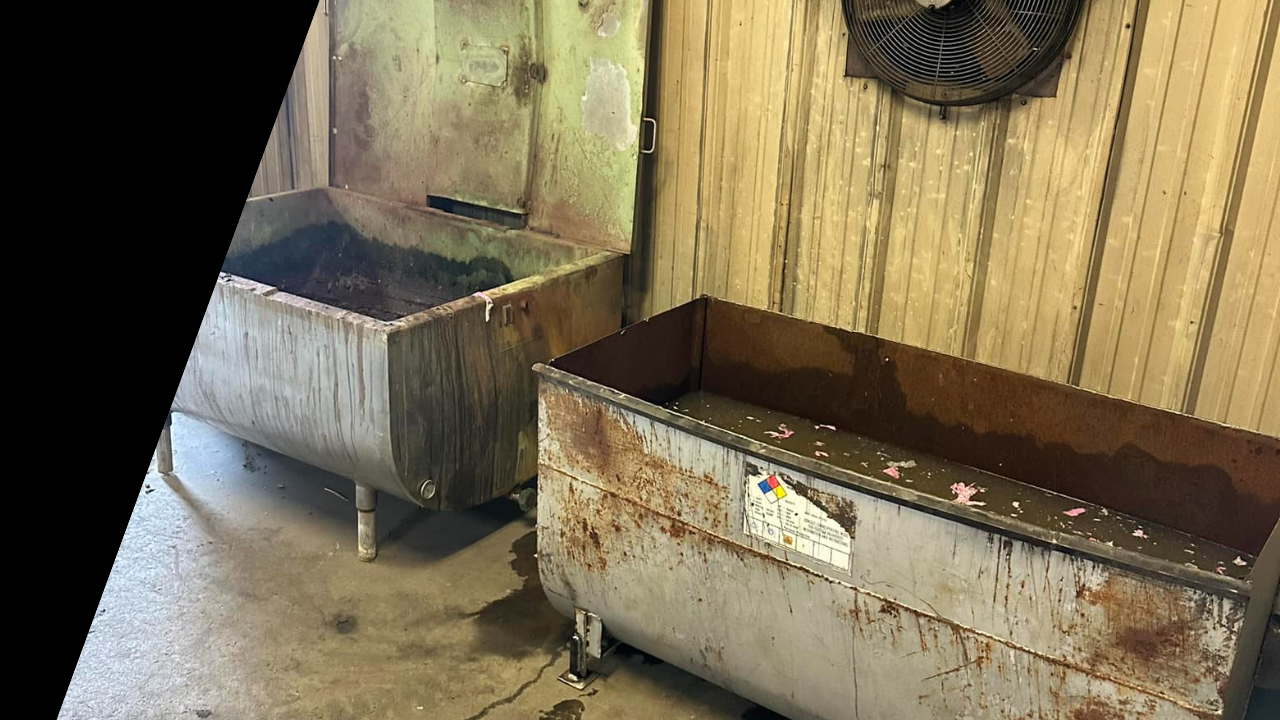
When it comes to powder coating, surface imperfection or paint removal in any industry, efficiency is key. This efficiency extends to project timelines, health and safety practices, and the quality of work.
There are various ways to remove paint, powder coating, and unwanted surface residues. The easiest option often seems to be methods using hazardous chemicals, protective measures and additional floorspace to accommodate these processes. As powder coat stripping chemicals pose several challenges, finding chemical stripping substitutes becomes essential to your business’s safe operation and overall efficiency.
Chemical Stripping Methods
Chemical stripping is used in various industries, including aerospace, military, and automotive, to remove paint, coatings, and other materials to restore original surfaces or prepare surfaces for refinishing.
Solvent-Based Strippers
Solvent-based strippers use organic solvents like acetone, ethyl alcohol, and methylene chloride. Methylene chloride, or dichloromethane, has a chloroform-like odor and is a colorless, volatile liquid that is potent enough to dissolve coatings like paints and powder coating finishes effectively. These strippers are fast-acting and efficient on various types of coatings, including degreasing. They are not environmentally friendly and must be handled in a well-ventilated environment with protective gear because this material is hazardous to human health.
B17 Powder Coat Remover
Benco B17 is a powerful solvent-based powder coat remover often used on metal surfaces, especially in the industrial, automotive, and manufacturing industries. The exact formulation varies according to the manufacturer, but one of its ingredients is always a high concentration of methylene chloride.
Caustic-Based Strippers
Caustic-based strippers remove paint and other organic coatings from metal surfaces but are ineffective at removing rust and most corrosion. They use alkaline solutions like sodium hydroxide, which breaks down organic materials. The intensity of this solvent can damage some substrates with improper use and requires neutralization after use.
Biochemical Strippers
Using natural ingredients like microorganisms or enzymes, biochemical strippers break down coatings with a slightly lower environmental impact than other chemical strippers. However, they are slower-acting and effective on a smaller range of materials.
Acidic Strippers
Acid solutions like phosphoric or hydrochloric acid remove coatings and can be used to etch some metallic surfaces chemically. These solutions apply more to metal part cleaning before painting or plating and are efficient for rust removal. Improper acidic stripper use can corrode metals, and this substrate must be used with various safety precautions in place to avoid accidents.
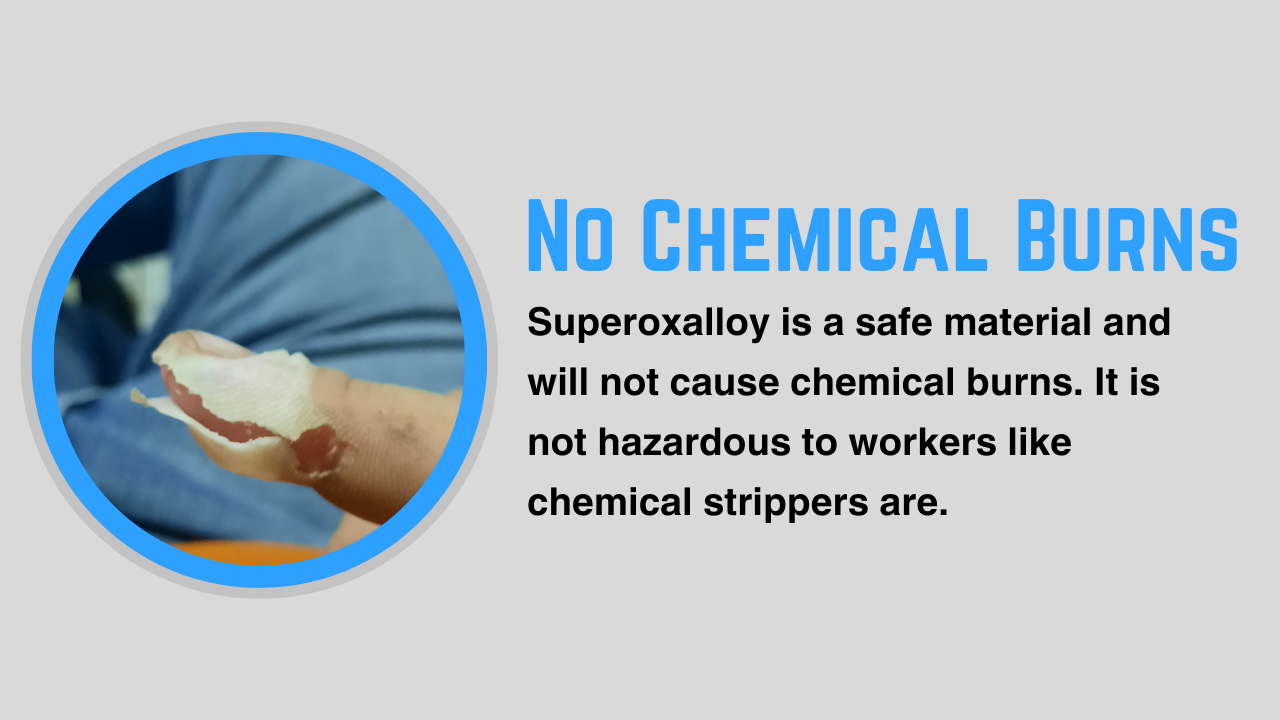
What Is B17 Stripper?
Benco B17 is made of a blend of different chemicals and solvents that break down the powder coating’s chemical bonds, making it easier to remove.
This stripper is available in a liquid form. It is fast-acting and must be washed off the surface after stripping to mitigate the risk of chemical reactions with other cleaners, paints or surface treatments. While this chemical stripper is extremely effective, there are a few B17 dangers and safety concerns to take into consideration:
- Flammability: Benco B17 can be highly flammable, and keeping it away from high heat sources or open flames is crucial.
- Toxicity: Like most chemical strippers, B17 acid vapors are toxic when inhaled, absorbed through the skin or ingested.
- Skin and eye irritation: Direct contact can cause chemical burns, skin irritation, and eye damage when employees do not wear goggles, gloves, or other PPE.
- Chemical reactions: Contact with chemicals or cleaning agents can produce toxic gases and increase flammability risks.
- Environmental hazards: Improper B17 stripper drum disposal can lead to environmental contamination. These containers can often go back to the manufacturer for disposal.
This product requires a significant financial investment for purchasing and ensuring you have the right PPE and workspace setup. It also slows down its processes in cold weather, so you may need to heat up the material before use in cold conditions.
Understanding the Dangers of Chemical Strippers
Understanding the health hazards associated with chemical strippers is a good starting point for understanding why it is crucial to find chemical stripping substitutes.
Acute exposure to chemical strippers can cause respiratory irritation, leading to wheezing, shortness of breath, and coughing. It can also affect the central nervous system. Even short-term exposure to high concentrations of a chemical like methylene chloride can cause nausea, dizziness, headaches, and loss of coordination. High-level exposure has a depressant effect on the central nervous system and can have severe repercussions like loss of consciousness or death.
Prolonged exposure can start showing signs of renal impairment and liver dysfunction. As the body can metabolize methylene chloride to carbon monoxide, employees can experience cardiovascular distress from elevated blood-carboxyhemoglobin levels. In fact, the EPA now bans most uses of methylene chloride, as chronic exposure increases the risk of developing breast, liver, lung, brain, blood, and central nervous system cancers.
Direct contact with these chemicals can cause dermal irritation, damaging the skin barrier and causing drying and cracking. Dermal absorption poses the risk of system toxicity and sensitization. This type of repeated or prolonged skin contact also causes allergic reactions.
As a result of their dangers, OSHA has stringent rules for handling chemical strippers and has limited the use of methylene chloride-containing products. It is essential to implement proper safety measures to minimize the hazardous effects of chemical strippers. These include:
- PPE: When using chemical strippers, employees must wear PPE such as goggles, protective clothing, gloves, and a face shield to reduce skin contact.
- Respiratory protection: Respiratory protection includes respirators or masks, which reduce chemical vapor exposure protection.
- Ventilation: Chemical strippers must be handled in a well-ventilated area to lower inhalation exposure.
- Storage and handling: It is vital to follow the safety guidelines for chemical handling and storage to prevent accidental exposure.
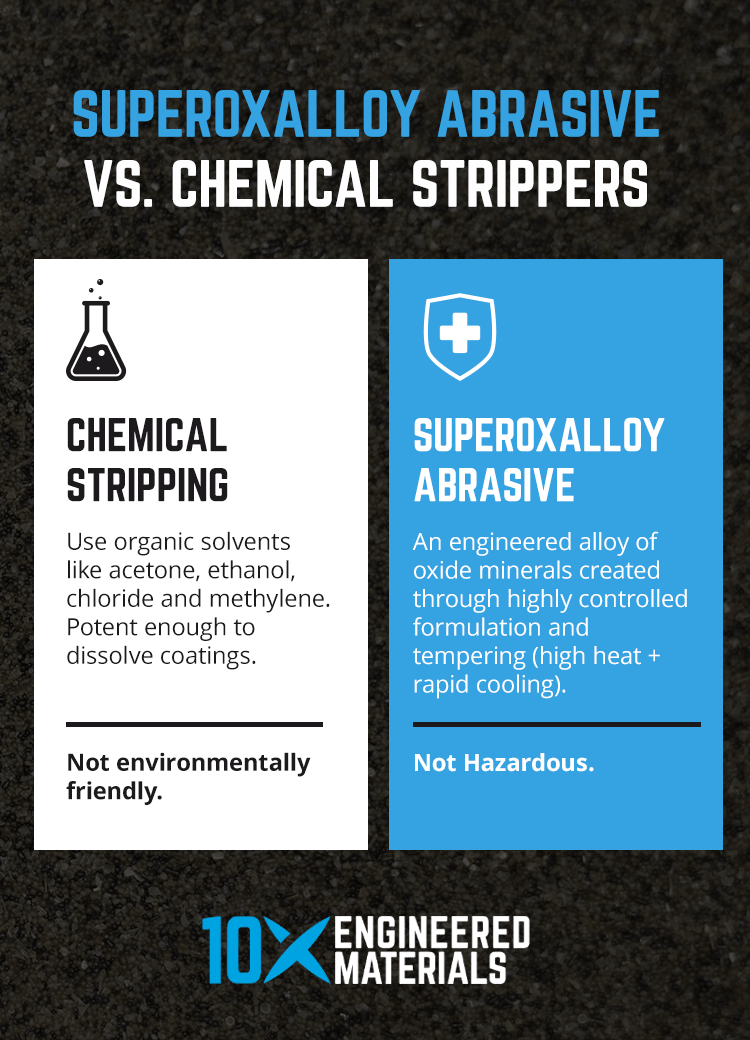
Chemical Stripping Alternatives
Methylene chloride alternatives cover various chemical stripping substitutes. These alternatives include mechanical methods, biochemical strippers and more — including superoxalloy abrasives. Blasting is generally a chemical-free solution and an efficient B17 substitute.
Mechanical Methods
Abrasive blasting uses materials like glass beds, sand, or steel grit propelled at high speeds to remove coatings. It is effective on heavy coatings and large surfaces but requires proper safety measures to protect operators against dust and debris.
Manual sanding and grinding are suitable for smaller areas and detailed work, but they are labor-intensive and can be costly compared to other methods.
Heat-Based Methods
Heat guns soften coatings to simplify scraping them off. They are useful in peeling off paint and varnish but are not suitable for all types of surfaces or coatings.
Infrared strippers use infrared radiation to heat a coating, which causes it to bubble and start separating from the surface. These strippers are efficient and reduce the risk of damage to the underlying surface.
Eco-Friendly Alternatives
Biological strippers, which use bacterial or natural enzymes to break down coatings, are environmentally friendly and less toxic to workers. However, these methods are not fast-acting and are only suitable for limited applications. Soy-based strippers, which are made from soybeans, are also biodegradable and less toxic.
Water-Based Strippers
Water-based strippers combine water with emulsifiers, biodegradable surfactants, and small amounts of solvents to break down and lift coatings from surfaces. Compared to solvent-based strippers, they contain fewer volatile organic compounds (VOCs), making them safer to use and better for the environment. However, they are generally considered to be less effective than harsher chemical-based strippers like Benco B17.
Laser Removal
Laser paint ablation uses functional lasers to remove coatings from a surface using laser radiation. It removes the coating by focusing a LASER on the surface; the paint or coating system absorbs the laser energy, which causes rapid heating and vaporization of the coating layer. This process is called sublimation, where paint becomes a gas without passing through a liquid phase. It is suitable for intricate or delicate surfaces as there is minimal risk of damaging the underlying surface. However, it requires a substantial investment compared to other methods due to the need for specialized equipment and additional staff training.
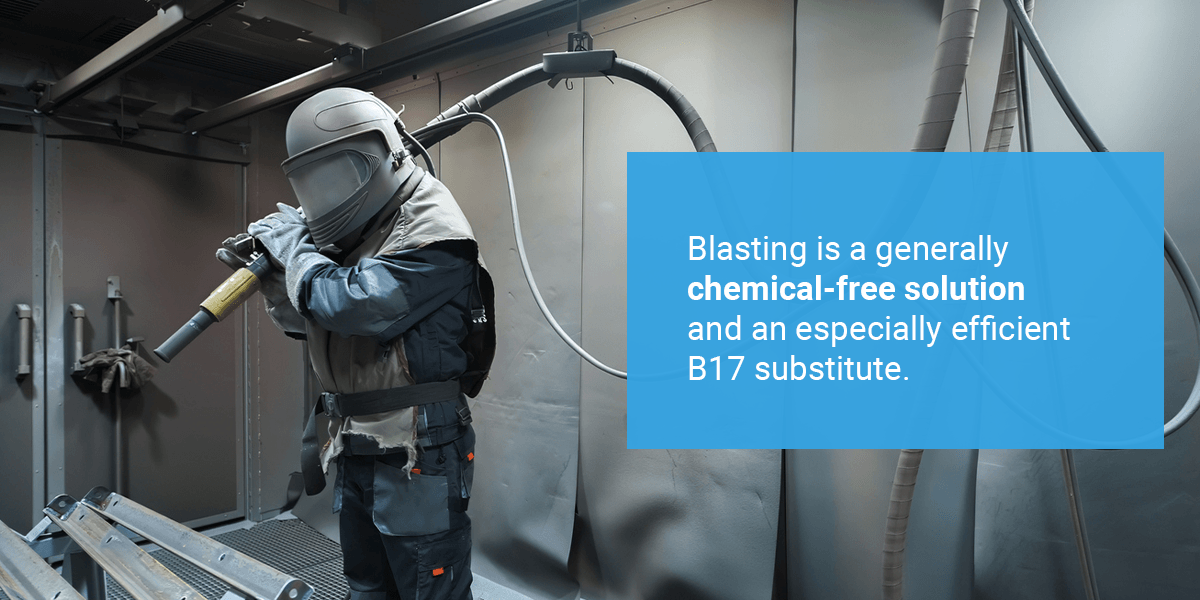
What Are Superoxalloy Abrasives?
Superoxalloy is an engineered alloy of oxide minerals created through highly controlled formulation and tempering (high heat + rapid cooling). It is one of the top alternatives to chemical stripping, effectively removing tough coatings, including powder coatings, and leaving a clean, ready-to-coat surface profile. Superoxalloy is also not affected by cold weather. Several additional benefits include:
- Precision and control: These abrasives offer precise control over the stripping process, minimizing damage to the underlying material. This characteristic is crucial in high-tech industries that must preserve the base material’s integrity.
- Material compatibility: Superoxalloy is compatible with various materials, including sensitive and high-performance alloys.
- Safety: Superoxalloy abrasives pose fewer health risks compared to chemical strippers. 10X Engineered Materials’ superoxalloy is made from mineral wood dust, which is biosoluble in the lungs.
- Low dust: Superoxalloy abrasives help deliver high-quality results in less time by creating a low-dust work environment.
- Strong: Superoxalloy abrasives are reusable and resistant to breakage. They have no fracture planes and resist breakage up to 120PSI and more.
Superoxalloy abrasives leverage the advanced properties of superalloys, delivering superior performance in demanding applications. They offer more efficiency, precision, and enhanced durability and leave a clean substrate that is essentially free of embedded particles, contributing to the quality of the abrasive-blasted surface.
A Breakdown of Superoxalloy Abrasive vs. Chemical Strippers
Superoxalloy is an engineered alloy of oxide minerals created through highly controlled formulation and tempering (high heat + rapid cooling). It is made from mineral wool insulation particles with a patented mix of shapes. Each shape performs different tasks in blasting jobs, performing multiple blasting steps in a single pass.
The superoxalloy production process creates amorphous particles resistant to breakage under the stress of high-speed mechanical impact. Compared to traditional chemical strippers, superoxalloy abrasives offer several stand-out advantages:

Why Choose Superoxalloy
Superoxalloy is the best replacement for methylene chloride. It is an excellent choice for sandblasting thanks to its clean health and safety profile, which promotes employee well-being and lowers environmental impact.
10X Engineered Materials offers three powerful superoxalloy products to help lower the surface prep cost per square foot in your projects:
- EpiX: EpiX superoxalloy abrasive is efficient in powder coating removal in medical devices, aviation, and more. It is also suitable for surface preparation in original equipment manufacturing.
- DynamiX: DynamiX is a heavy-duty remover used on bridges, ship hulls, rail cars, water towers, and more.
- KinetiX: KinetiX is used in high-volume, demanding blasting jobs, especially for preparing the surfaces of pipelines and process equipment.
Superoxalloy Client Testimony
Karlos’ company originally used B17 stripping chemical as part of a multi-step surface preparation process, which also included aluminum oxide and glass bead blasting. These processes used dangerous chemicals and did not support their operational efficiency. Processing one part could take up to seven hours.
Using superoxalloy, their processes have become simplified, safer and more efficient. One blast with EpiX eliminated the need for any chemical stripping. This switch is saving the company over $5,000 a week while increasing per-part profitability by 50%, just by eliminating the use of a chemical stripper. Their annual insurance premiums went from $18,000 to $6,000 — switching to EpiX eliminates their employees’ hazardous chemical exposure. They are also enjoying better employee satisfaction as their finish quality is much higher than it was before using EpiX.
Shop Superoxalloy Abrasives From 10X Engineered Materials
Superoxalloy abrasives effectively remove various coatings, can be more precise and are less reliant on chemicals, making them a suitable solution for detailed work and environmentally conscious projects. They are an excellent alternative to Benco B17 and other highly damaging chemical strippers.
Make an engineered decision with our superoxalloy abrasives. Our goal is to provide you with a cost-effective solution that delivers superior surface preparation results. We offer a range of superoxalloy products that support various applications, improving project efficiency and creating a safer work environment.
Contact us today for safer abrasive media and learn more about how 10X Engineered Materials can assist with your projects.

